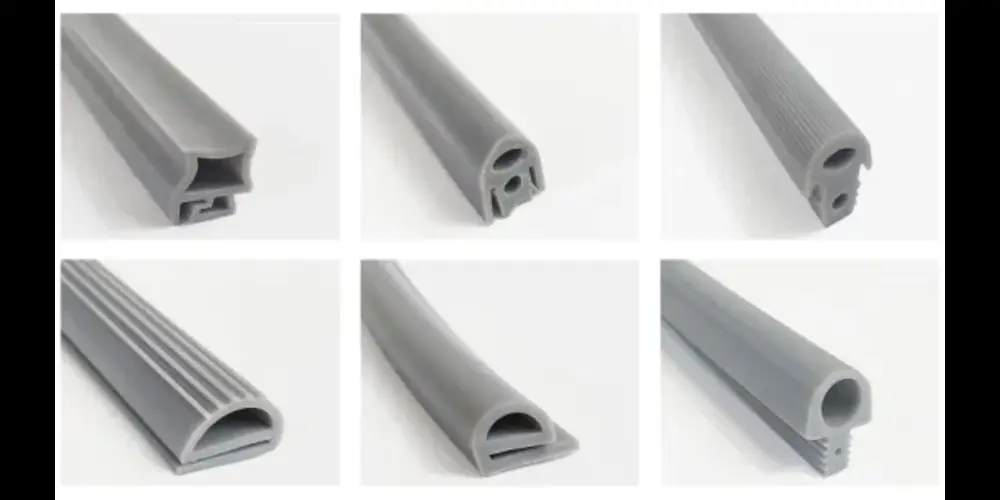Rubber Seal Strips: All You Need to Know

What is Rubber Seal Strip?
A seal strip is made of synthetic rubber that prevents liquids and gases from leaking. Weatherstripping seal strips are the best example of strip steel. Typically, these seal strips are extremely common for residences for weather protection. A rubber seal strip closes the gap between components in a machine steady and parts that move. It keeps the device safe from things like humidity and temperature.
Types of Rubber Seal Strips
There are numerous varieties of rubber seal strips on the market. Each type contains distinctive characteristics and properties that suit specific sealing applications. The following are some common varieties of rubber seal strips:
Sponge Rubber Seal Strip
Sponge rubber seal strips contain sponge-like materials like EPDM, neoprene, or PVC. They are compressible and lightweight, which makes them ideal for sealing uneven or irregular surfaces. Sealing doors, windows, and sections with sponge rubber seal strips is common in the automotive industry.
Rubber Seal Strips Solid
Solid rubber seal strips contain solid rubber materials like neoprene, EPDM, or silicone. They are dense and resistant to extreme temperatures and chemicals. Solid rubber seal strips suit outdoor applications requiring long-lasting and durable sealing.
Strips Conductive Rubber Seal Strip
Conductive rubber seal strips comprised of carbon or metal particles blended with rubber. Employed in applications requiring electrical conductivity
Co-extrusions Rubber Seal Strips
Co-extruded rubber seal strips consist of two or more extruded rubber materials. They have exceptional sealing and padding capabilities and are suitable for various applications. Co-extruded rubber seal strips can be built with different shapes and colors to meet the application’s needs.
Material Classification Used for Rubber Strips
The material employed in the manufacturing process of Rubber Strip is crucial, as it affects its overall properties. The following materials were used in the production of these parts:
Nitrile rubber
Nitrile, known as NBR, is a material numerous manufacturers use due to its superior oil resistance. Typically, a rubber seal from this material is installed in a vehicle’s engine.
This rubber is another material that resists extreme temperatures very well. In addition, it is resistant to ozone, ultraviolet light, and harsh climatic conditions. As a result, it has numerous applications in aerospace sealing.
Butyl rubber
This material has low gas and water vapor permeability. It is highly flexible and resistant to chemicals, gases, ozone, and the elements.
Neoprene rubber
This material, chloroprene rubber, is highly durable and flexible. Yet, it is a popular choice for applications requiring high chemical resistance. In addition, its resistance to ozone and weather conditions is exceptional.
EPDM rubber
EPDM is a great material for a rubber seal because it is durable and retains flexibility even at high temperatures. Additionally, it is resistant to all weather conditions and a wide spectrum of temperatures.
Silicon rubber
This material demonstrates resistance to extreme temperatures. In addition, silicone rubber is extremely pure, so it is used extensively in medical and food applications.
SBR rubber
Styrene-butadiene rubber is a widely used type of rubber. It is primarily employed in producing rubber strips with no particular features.
Benefits of Rubber Seal Strip
- Corrosion and abrasion resistance
- Noise reduction
- Airtight and watertight sealing
- Vibration damping
- Protection against heat and cold
The Applications of Rubber Seal Strips
Rubber Strips have been used in a wide range of applications. It is an integral component of all daily-use appliances. Here are some applications of rubber seal strips.
Automobiles
Various rubber seals are used in automobiles, aircraft, and other vehicles. These components serve to seal the vehicle’s inside engine. Therefore, a Rubber Strip must conduct heat and electricity. It also possesses chemical and mechanical resistance.
Home appliances
Numerous domestic appliances employ some rubber seal. Yet these are suitable for food, resistant to high and low temperatures, and electrically insulating. The vast majority of kitchen appliances contain some of its most common applications. The effective operation of the refrigerator and freezer depends on a rubber strip. Yet, it prevents heat from entering the appliance and spoiling the food. You can also find Rubber Strips on the door of your washing machine and at the bottom of your garage door.
Plumbing
In plumbing, impenetrable seals provide the most effective waterproofing solution. As a result, they are most commonly used around faucets. In addition, plumbers typically install a Rubber Strip around the bathtub and in the bathroom to prevent mold growth.
Engines
In engines, rubber seals prevent lubricants and chemicals from leaking out of tubes and causing machine damage. In addition, they are situated between the various engine components to prevent them from coming into contact.
Conclusion
Rubber Seal Strips are essential components of cabinets and machinery. It protects the cabinets and machinery from the severe external environment, such as rain, wind, dust, etc. It protects the machine’s parts from vibrations, motion, and friction.
Read More From Techbullion





